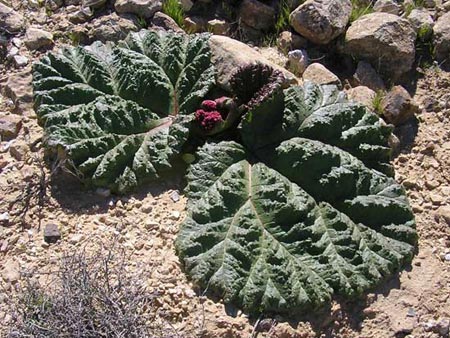Plants have the ability to lead water to their roots
The rhubarb trees in the desert of Israel lead themselves to the water when it rains thanks to some special leaves. The amount of water they get in the year is 16 times that of other trees in the same area.

Special leaves of desert rhubarb tree.Deep grooves allow rain water to flow along the veins to the base.Photo: treknature.com.
Special leaves allow desert rhubarb ( Rheum palaestinum ) to grow in drought conditions. Three biologists from Haifa University (Israel) saw them when studying flora in the Negev desert. Curiosity emerged when they saw veined leaves forming a rosette-like figure on the ground. They are different from the tiny leaves of most desert plants.
Professor Simcha Lev-Yadun, a member of the research team, said: 'The shape of the leaves allows them to lead water to the central area. That stimulates our imagination '.

A desert rhubarb tree blooms.Photo: BBC.
After several days of monitoring, the three scientists found that each rhubarb in the Negev desert obtained an average of 4.2 liters of water per year, while the largest tree caught 43.8 liters. The deep concave in the leaves of the rhubarb makes the water run to the root. The leaves are also covered with a cuticle (transparent like wax) that pushes water through the leaves.
The Negev desert rarely rains with an average annual rainfall of 75 mm. But even in the smallest rain, water can flow from the rhubarb leaves to the root. The three scientists found water to reach a depth of 10 cm in the soil. Meanwhile, rainwater only reaches 1 cm depth in the desert.
'Rosemary leaves allow the rhubarb to receive 16 times more water than other plants in the desert, which is equivalent to the amount of water the plants live in the Mediterranean region. Perhaps this is the only plant in the Middle East that has this unique ability. We also know that all deserts in the world do not have similar plants , 'Professor Lev-Yadun said.
- Japan develops technology to help roots grow three times faster
- Techniques for growing and caring chrysanthemum plants
- Collect water in the air to grow plants in the desert
- The 'zombie' tree is fed by the forest
- Lead poisoning water crisis in the US city
- To what extent is lead sludge spilled into dangerous rivers?
- The tree knows 'talking, sending messages' like people
- Do you have to remove potting covers when planting trees?
- Why are trees being 'wilted down' when water is lacking?
- Resistance against HIV with royal tree roots
- The herb species moves backwards, surprising the viewer
- There is no brain but plants are smarter than we think
 Why do potatoes have eyes?
Why do potatoes have eyes? 'Tragedy' the world's largest carnivorous life: Death becomes ... public toilet
'Tragedy' the world's largest carnivorous life: Death becomes ... public toilet Tomatoes were once considered 'poisonous' for 200 years
Tomatoes were once considered 'poisonous' for 200 years Detecting microscopic parasites on human face
Detecting microscopic parasites on human face